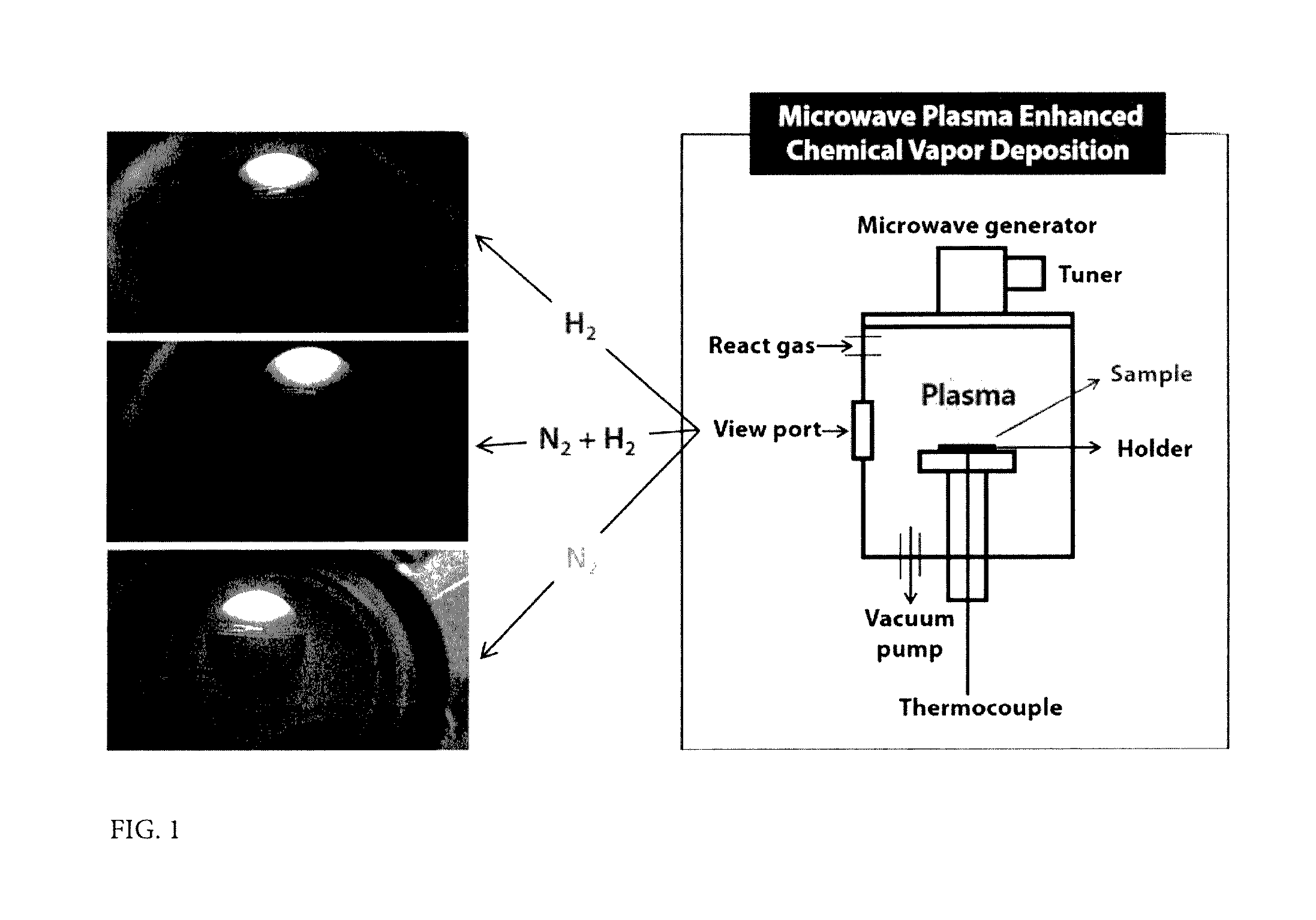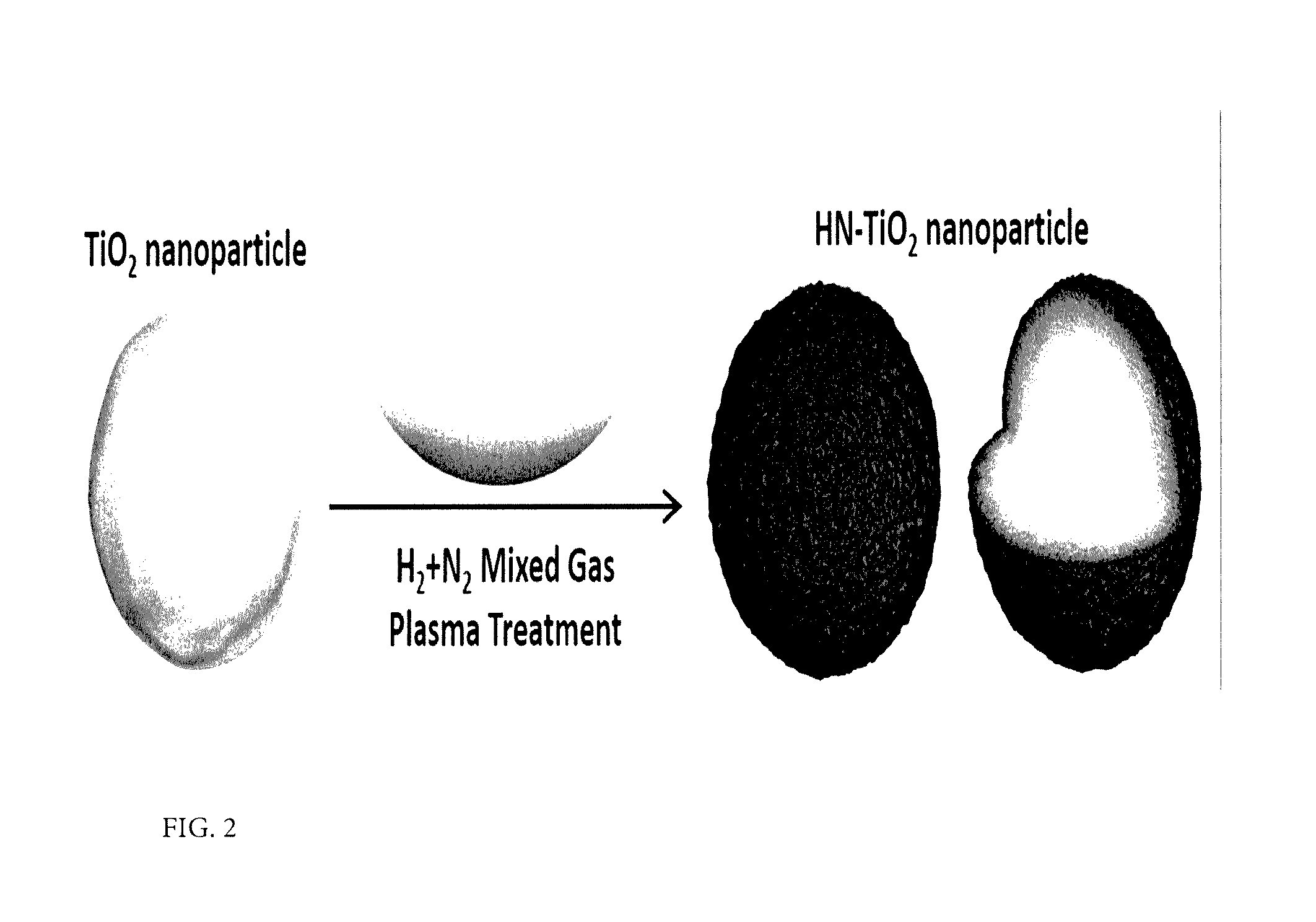Method for improving solar energy conversion efficiency using metal oxide photocatalysts having energy band of core-shell for ultraviolet ray and visible light absorption and photocatalysts thereof
- Summary
- Abstract
- Description
- Claims
- Application Information
AI Technical Summary
Benefits of technology
Problems solved by technology
Method used
Image
Examples
example 1
[0048]A method of fabricating a photoelectrochemical electrode is as follows. 100 mg of anatase TiO2 nanoparticles having a particle diameter of about 25 nm was sufficiently dispersed in 50 ml of acetone solution containing 20 mg of iodine dissolved therein. Two nickel foils were immersed in the prepared solution so as to face each other, and then, 100V DC was applied to the same for 1 minute, to form a TiO2 nanoparticle thin film layer having a thickness of about 250 nm on the nickel foil side of a cathode. The TiO2 thin film sample was subjected to heat treatment at 500° C. in an air atmosphere for 40 minutes to improve adhesion between the thin film layer and the nickel foil substrate and, at the same time, to remove organic impurities formed in the thin film fabrication process. A variety of metal oxides such as V, Fe, Cu, Zn, Ta, W or Bi, etc. metal oxide nanoparticles (<50 nm) may also be fabricated into a photoelectrochemical electrode by the same process as described above.
[...
example 2
Fabrication of HN—TiO2—Cu Catalyst
[0050]A method for fabricating a transition metal thin film serving as a co-catalyst for the HN—TiO2 photoelectrochemical thin film electrode prepared by the above-described method is as follows. Using a RF magnetron sputtering device, a transition metal target such as Cu, Pt, Co, etc. was deposited on the prepared HN—TiO2 thin film sample. After injecting argon gas, a pressure was adjusted to 12 mTorr and the deposition was performed under a RF power (Radio Frequency) of 100 W for 0 to 120 seconds. A weight of the deposited co-catalyst was measured using an ultra-micro balance and was controlled to be 1% or less as compared to TiO2 thin film. The transition metal-deposited sample was subjected to heat treatment under a temperature condition of about 100° C. and in nitrogen and hydrogen gas atmosphere for 1 hour, thereby improving adhesiveness and crystallinity.
example 3
Production of Cl Compound Using HN—TiO2—Cu Catalyst
[0051]A measurement method of photochemical conversion efficiency from photochemical carbon dioxide to another carbon compound is as follows. In order to maximize the catalysis efficiency, platinum or copper (serving for reduction of carbon dioxide) and a cobalt oxide thin film were deposited on the fabricated HN—TiO2 thin film using a RF magnetron sputtering device. After placing the prepared sample in a sealed stainless steel container, air was discharged and an inside of the container was became a saturated condition using carbon dioxide gas (99.9%) at a temperature of about 70° C. Then, after pouring a small amount of deionized water therein, the temperature was maintained at 70° C. for about 1 hour in order to sufficiently evaporate the reactants in the reactor. For photochemical catalytic reaction, a quartz glass at the top of the container was irradiated with light using a light simulator (AM 1.5G filter, 200 mWcm−2) to condu...
PUM
| Property | Measurement | Unit |
|---|---|---|
| Molality | aaaaa | aaaaa |
| Molality | aaaaa | aaaaa |
| Molality | aaaaa | aaaaa |
Abstract
Description
Claims
Application Information
 Login to View More
Login to View More - R&D
- Intellectual Property
- Life Sciences
- Materials
- Tech Scout
- Unparalleled Data Quality
- Higher Quality Content
- 60% Fewer Hallucinations
Browse by: Latest US Patents, China's latest patents, Technical Efficacy Thesaurus, Application Domain, Technology Topic, Popular Technical Reports.
© 2025 PatSnap. All rights reserved.Legal|Privacy policy|Modern Slavery Act Transparency Statement|Sitemap|About US| Contact US: help@patsnap.com



